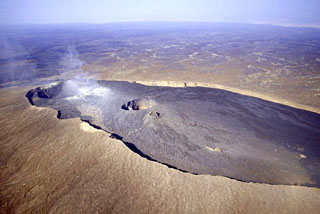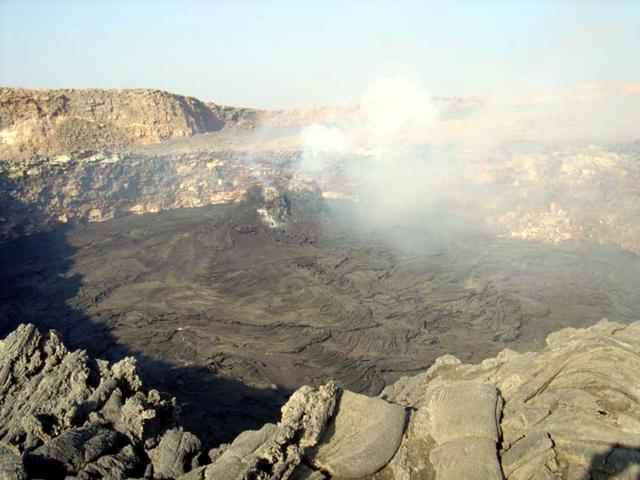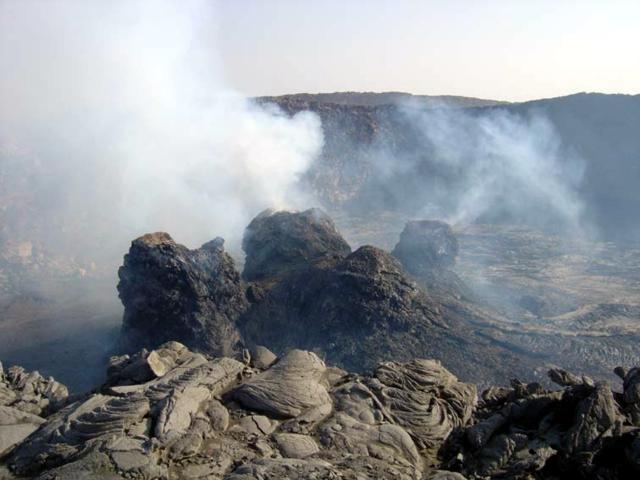Report on Erta Ale (Ethiopia) — November 2004
Bulletin of the Global Volcanism Network, vol. 29, no. 11 (November 2004)
Managing Editor: Richard Wunderman.
Erta Ale (Ethiopia) On 4-5 December 2004 visitors noted active hornitos but solidified lava lake
Please cite this report as:
Global Volcanism Program, 2004. Report on Erta Ale (Ethiopia) (Wunderman, R., ed.). Bulletin of the Global Volcanism Network, 29:11. Smithsonian Institution. https://doi.org/10.5479/si.GVP.BGVN200411-221080
Erta Ale
Ethiopia
13.601°N, 40.666°E; summit elev. 585 m
All times are local (unless otherwise noted)
Two teams sent reports on Erta Ale's behavior in December 2004. On 1-5 December the visiting team included Jacques-Marie Bardintzeff and a group from Ushuaia Nature, and on 4-5 December the team consisted of the volcanology travel group SVE-SVG. Both groups submitted similar reports and commented on substantial changes they observed compared to conditions described in past reports (most recently, BGVN 29:08). Although Erta Ale frequently contains a lava lake with an open surface of molten lava, that was not the case this time.
The lava lake's surface had chilled within the small (~ 200-m-diameter) S pit crater (figure 14). A solidified lava crust covered the crater floor. The crust's surface sat ~ 15 m below the W crater rim, and ~ 30 m below the E crater rim. On top of this crust stood four coalesced hornitos in the SE part of the S crater (figure 10). They were ~ 10 m high and represented the only portion of the crust where molten material was in evidence. Two hornitos emitted high temperature (more than 500°C) SO2-rich gas. Another hornito contained glowing molten lava. During the night of 4 December the SVE-SVG group saw degassing and incandescent lava at the summit of two of these hornitos. Bardintzeff described sampling molten material from 12 m depth, in one of the hornitos using a cable and an iron mass (figure 15).
The SVE-SVG team noted recent activity within the North crater, where an uplifted area termed a 'lava bulge' had solidified. It covered ~80% of the crater floor and rose to about 20-25 m below the crater rim. In the lava bulge's central area, strong and noisy degassing of SO2 spouted from several small hornitos. At the bulge's periphery the observers saw ten small incandescent vents. Subsequently, two plumes rose above the volcano.
Geological Summary. The Erta Ale basaltic shield volcano in Ethiopia has a 50-km-wide edifice that rises more than 600 m from below sea level in the Danakil depression. The volcano includes a 0.7 x 1.6 km summit crater hosting steep-sided pit craters. Another larger 1.8 x 3.1 km wide depression elongated parallel to the trend of the Erta Ale range is located SE of the summit and is bounded by curvilinear fault scarps on the SE side. Basaltic lava flows from these fissures have poured into the caldera and locally overflowed its rim. The summit caldera usually also holds at least one long-term lava lake that has been active since at least 1967, and possibly since 1906. Recent fissure eruptions have occurred on the N flank.
Information Contacts: Jacques-Marie Bardintzeff, Laboratoire de Pétrographie-Volcanologie, Bât. 504, Université Paris-Sud, F-91405, Orsay, France (URL: http://www.lave-volcans.com/bardintzeff.html); Henry Gaudru, Société Volcanologique Européenne (SVE), C.P.1-1211 Geneva 17- Switzerland (URL: http://www.sveurop.org/).



